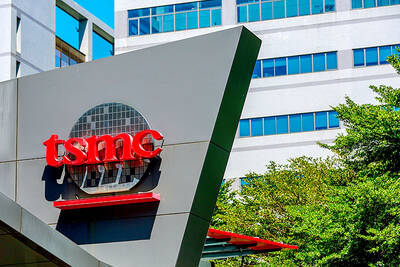DBS Bank Ltd (星展銀行) on Wednesday cut its forecast for Taiwan’s economic growth for next year to 2.3 percent, after in April estimating 3 percent GDP growth, citing downside factors such as a global trade slowdown and a decrease in private investment.
The bank said in a report that it reduced the predictions for Taiwan’s goods exports growth and private investment next year to 1.4 percent and 1.7 percent respectively, compared with 1.9 percent and 3 percent in its April forecast, adding that Taiwan is vulnerable to trade recessions.
Private investment would decelerate amid a global economic slowdown, the bank said.

Photo: CNA
“However, [improving] demand after border reopenings, flexible macroeconomic policies and structural tailwinds are expected to provide some buffer,” Singapore-based DBS economist Ma Tieying (馬鐵英) said in the report.
The bank raised its forecast for private consumption to 2.7 percent, from 2.4 percent forecast in April, saying that spending would likely benefit from border reopenings as the COVID-19 pandemic subsides, Ma said.
“Reopening should be an important growth driver [for the Taiwanese economy] in 2023,” Ma said.
Taiwan earlier this month raised a cap on the number of foreign visitors to 200,000, aiming at a maximum of 10 million foreign visitors a year, almost on par with pre-pandemic levels, Ma said.
Considering that Chinese tourists might not return soon, the bank assumes a 70 percent recovery in visitor arrivals, which would generate services export revenues of NT$10 billion (US$325,63 million), equivalent to 1.3 percent of Taiwan’s GDP, Ma said.
Service sectors, such as transportation, accommodation, food catering, recreation and entertainment, could benefit the most, she added.
DBS Bank expects government spending and public investment to pick up next year, as Taiwan is to adopt an expansionary fiscal policy, the report said.
There is adequate leeway for the government to implement such a policy to counter the risk of a growth slowdown, as its debt-to-GDP ratio as of last year remained low and stable at 26 percent, thanks to successful COVID-19 management and resilient economic performance in the past three years, Ma said.
Overall, GDP growth next year is expected to slow to 2.3 percent, which would be close to the growth rates during the European debt crisis in the early 2010s, but better than the contraction after the dot-com crash in 2001, and the global financial crisis in 2008 and 2009, she said.
DBS said inflation would rise at a slower rate of 1.8 percent next year, allowing the central bank to pause monetary tightening after its meeting in March, Ma said.
The benchmark discount rate could stay at 1.875 percent after the meeting, she added.
However, geopolitics and tensions across the Taiwan Strait would likely remain the key risks next year, DBS said, adding that China’s large-scale military exercises around Taiwan in August forced many shipping companies and airlines to divert their routes, resulting in a temporary increase in freight costs.

RUN IT BACK: A succesful first project working with hyperscalers to design chips encouraged MediaTek to start a second project, aiming to hit stride in 2028 MediaTek Inc (聯發科), the world’s biggest smartphone chip supplier, yesterday said it is engaging a second hyperscaler to help design artificial intelligence (AI) accelerators used in data centers following a similar project expected to generate revenue streams soon. The first AI accelerator project is to bring in US$1 billion revenue next year and several billion US dollars more in 2027, MediaTek chief executive officer Rick Tsai (蔡力行) told a virtual investor conference yesterday. The second AI accelerator project is expected to contribute to revenue beginning in 2028, Tsai said. MediaTek yesterday raised its revenue forecast for the global AI accelerator used

Taiwan Semiconductor Manufacturing Co (TSMC, 台積電) has secured three construction permits for its plan to build a state-of-the-art A14 wafer fab in Taichung, and is likely to start construction soon, the Central Taiwan Science Park Bureau said yesterday. Speaking with CNA, Wang Chun-chieh (王俊傑), deputy director general of the science park bureau, said the world’s largest contract chipmaker has received three construction permits — one to build a fab to roll out sophisticated chips, another to build a central utility plant to provide water and electricity for the facility and the other to build three office buildings. With the three permits, TSMC

The DBS Foundation yesterday announced the launch of two flagship programs, “Silver Motion” and “Happier Caregiver, Healthier Seniors,” in partnership with CCILU Ltd, Hondao Senior Citizens’ Welfare Foundation and the Garden of Hope Foundation to help Taiwan face the challenges of a rapidly aging population. The foundation said it would invest S$4.91 million (US$3.8 million) over three years to foster inclusion and resilience in an aging society. “Aging may bring challenges, but it also brings opportunities. With many Asian markets rapidly becoming super-aged, the DBS Foundation is working with a regional ecosystem of like-minded partners across the private, public and people sectors

BREAKTHROUGH TECH: Powertech expects its fan-out PLP system to become mainstream, saying it can offer three-times greater production throughput Chip packaging service provider Powertech Technology Inc (力成科技) plans to more than double its capital expenditures next year to more than NT$40 billion (US$1.31 billion) as demand for its new panel-level packaging (PLP) technology, primarily used in chips for artificial intelligence (AI) applications, has greatly exceeded what it can supply. A significant portion of the budget, about US$1 billion, would be earmarked for fan-out PLP technology, Powertech told investors yesterday. Its heavy investment in fan-out PLP technology over the past 10 years is expected to bear fruit in 2027 after the technology enters volume production, it said, adding that the tech would